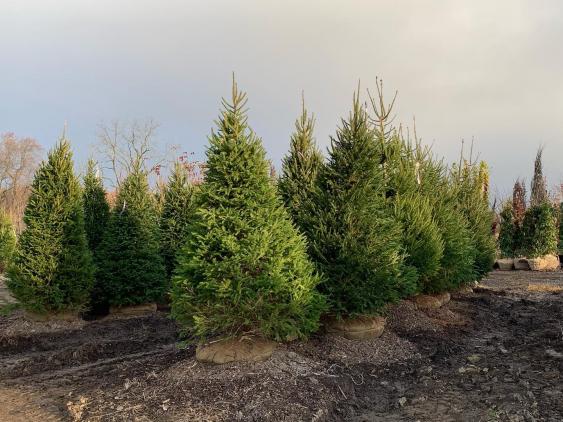Evergreens are such an important part of our landscape. Unlike deciduous plants that are bare in the winter months, evergreens keep their foliage all seasons. Planting evergreens on your property will reward you with lush, green foliage all year and give your yard the good bones and structure that make for great curb appeal.
Note that evergreens are merely a plant characteristic, not a botanical classification. An evergreen plant is any plant which has leaves present on the branches all year round; many (but not all) conifers are evergreen; many broadleaf plants are also evergreen such as rhododendrons, skip laurel, boxwoods, etc. As we previously mentioned, the opposite of evergreen is deciduous (shedding all the leaves for part of the year).
Why Evergreens Are the Best
- There are hundreds of varieties
- Assortment of color, texture and form
- Provide privacy
- Good backdrop in beds and borders
- Make a great focal point in a mixed bed
- Provide nesting and shelter for birds
- Keep foliage all seasons
One Basic Requirement for Evergreens
Although some evergreen shrubs and trees can handle some degree of shade, they will do better if they receive as much sunlight as possible. Sunlight is important for evergreens. The exception would be boxwoods, which can tolerate sun or shade.
Be Mostly Evergreen in Your Landscape Design
Some design experts feel that foundation plantings should consist of at least 50% evergreens, 25% deciduous plants and 25% perennials. This mix insures visual interest and texture year around. Plants like yew trees can be easily clipped and look great in your foundation plantings all throughout winter. Smaller deciduous flowering shrubs and hydrangeas look great interspersed with your foundation evergreens.
There are interesting evergreens that will give you different shades of green, golds and blue. Their unusual foliage forms will create special interest as well.
Interesting Evergreens that Add Color and Form to Yards
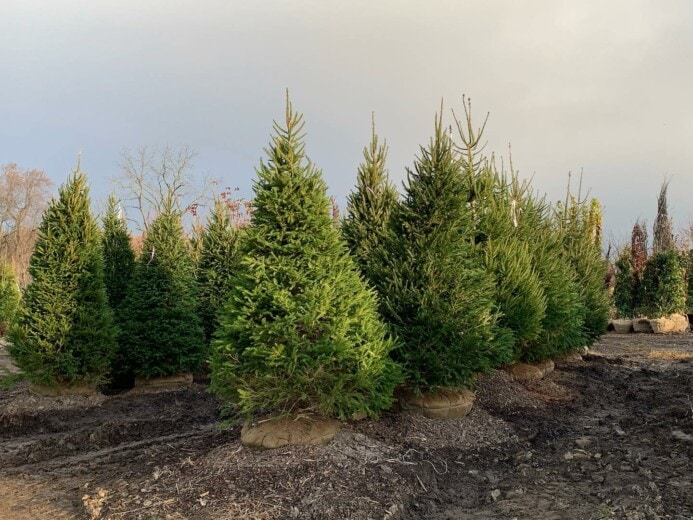
Norway Spruce. Photo credit: Harmony Hill Nursery
Norway Spruce – This is a fast growing tree with a growth rate of over 2 feet per year. It’s easy to grow, and makes a great tree for Christmas lights.
Weeping Norway Spruce – This slow-growing tree is famous for its unique trailing appearance. With support, it can grow to 15 feet tall but if not supported, can trail along the ground.
Globe Blue Spruce – Has icy blue needles that form a globe shape and is considered a slow grower. It works as a border plant for paths and reaches 3-5 feet tall and 5-6 feet wide.
Dwarf Alberta Spruce – A garden classic. Has a dense pyramidal shape and needs no pruning to stay perfectly neat. It will grow gradually to 6 feet tall and 3 feet wide when mature. Its lighter-green foliage is a good accent against the more normal deep greens of most evergreens. There’s also a compact version perfect for smaller gardens.
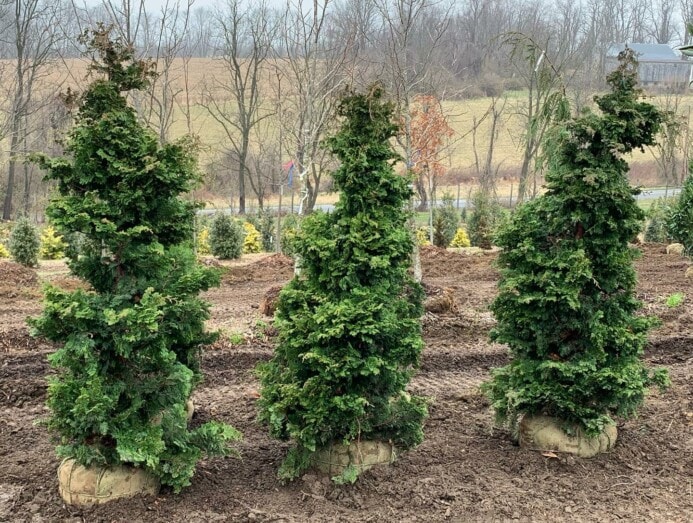
Hinoki Cypress. Photo Credit Harmony Hill Nursery
Hinoki Cypress – Typically turns beautiful shades of red in winter, but for gardens the most valuable are the numerous forms with yellow and gold branches. These are usually dwarf plants forming globes or pyramids, of dense, slightly irregular forms. They can be clipped into neater forms in you wish, although unclipped they probably have more character.
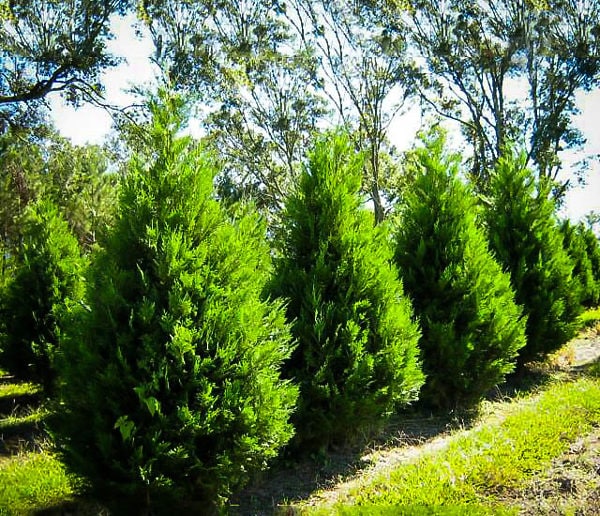
Leyland Cypress: Photo Credit: The Tree Center
Leyland Cypress – Is a fast-growing evergreen conifer and can grow 60 to 70 feet tall unless it is kept pruned. It won’t tolerate dense shade, and grows best in sun or partially shaded areas. There are many cultivars and shades of green and its branches form rounded, fan like sprays.
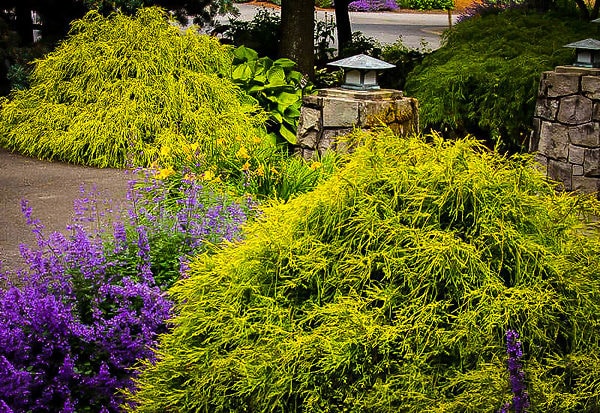
Gold Mop Cypress. Photo Credit: The Tree Center
Golden Mop Cypress – Brings solid yellow and gold color to the garden with thread-like foliage and a neat mounded shape which is broader than tall. Grows to around 3 to 4 feet tall and thrives in full sun. A great no-maintenance evergreen.
Pine Trees – Have a tall trunk and spreading crown. They make a handsome lawn specimen, growing up to 2 feet a year. There are also dwarf variations.
Mugo Pine – Different from other pines and grows as a rounded shrub, that is usually just a few feet tall. No pruning is needed.
Blue Star Juniper – Great for a small garden. It’s a tough plant, ideal for dry, hot spots. It forms a low rounded shrub and its foliage is dense and bushy. Has a remarkable shade of real blue and is low maintenance.
Additional Reading: 6 Compact Evergreen Shrubs for Your Yard and A Dwarf Arborvitae for Small Gardens – Tater Tot Arborvitae
Upright Juniper – Grows tall but remains compact so you can plant them tightly together to create a wall of greenery. Easy to grow and maintain. If your space is limited, this juniper is a good choice.
Creeping Juniper – This low-growing juniper spreads outwards instead of up, making it a fabulous ground cover plant. It does well in rocky, poor soils, and it’s terrific for preventing erosion on sloping terrains. In winter, its foliage takes on a slightly plum purple tint, bringing fabulous color contrast to the scenery. Creeping juniper spreads about 6–8 feet wide at maturity, so you can always cut it back if it’s getting too unruly.
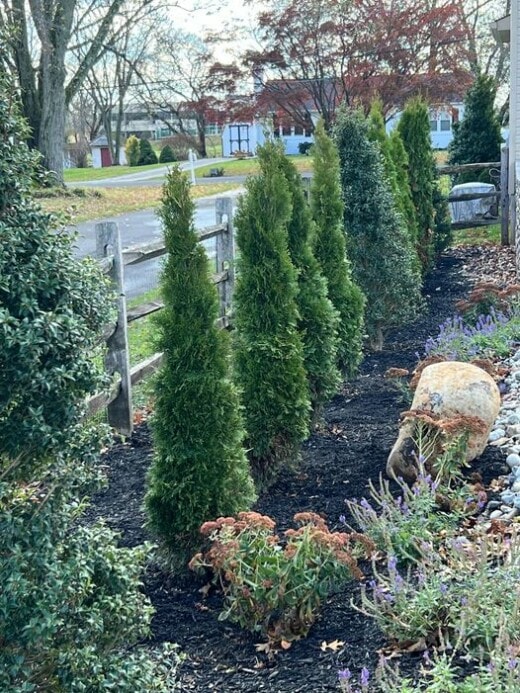
Recent planting of Emerald Green Arborvitae to create privacy.
Arborvitae – Lots of varieties and mostly are large. Often used as a screen along the property line or on the corner to frame a house. Emerald Green or North Pole Arborvitae grow to a height of 15 feet and the Thuga Green Giant is massive, growing up to 60 feet.
Additional Reading: How to Create Privacy in your Backyard
Yews – Commonly used as a hedge plan with dark green foliage. Many varieties have different heights and growth habits. Important to choose the right variety for the use you have in mind.
We hope you have fallen in love with evergreens. When choosing, go for something that has a lot of visual interest with its texture and habit or even an eye-catching color. But be aware of your space. You don’t want it to outgrow your space. The big ones can grow as large as 80 feet and the dwarf stay contained.
Choosing the right evergreens may seem overwhelming. We understand that homeowners do not have the expertise to get it right. That’s where we can help. Whitehouse Landscaping has the horticultural knowledge in landscaping to make sure the right plants are chosen for the right place insuring your landscape thrives and can be properly maintained. Our design experience can create an outdoor space that is beautiful, distinctive, livable and truly sustainable.
If you want to add some evergreens to your landscaping, or have questions about your landscaping, call Whitehouse Landscaping at 484-300-4290 or contact us on our website. We’re always happy to help you.

